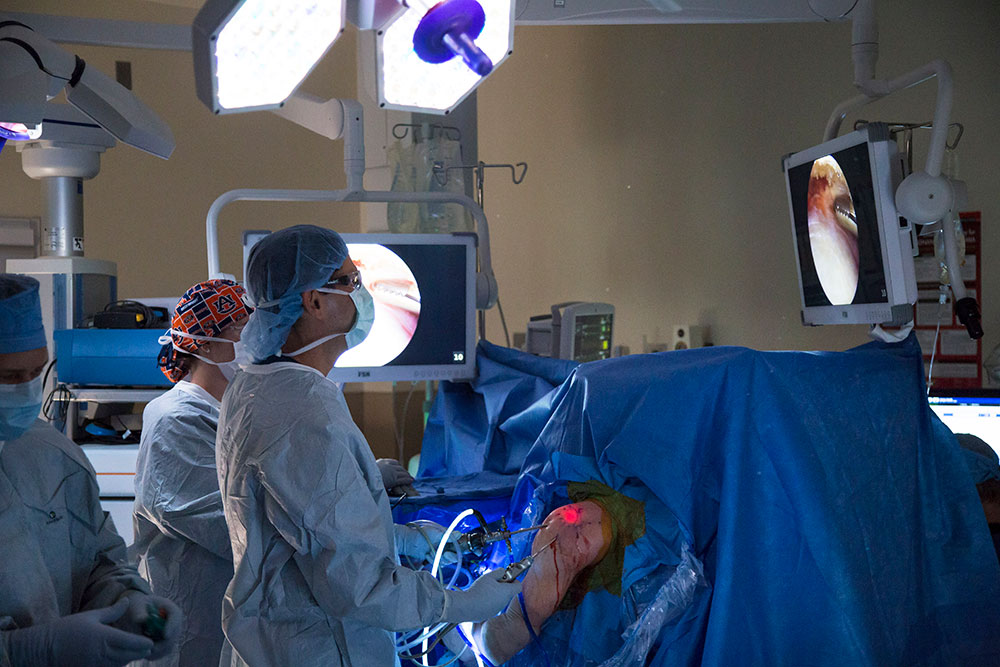
Richard Cunningham, MD – a top rated, board certified orthopedic surgeon and sports medicine specialist at Vail-Summit Orthopaedics & Neurosurgery has a clinical focus on the treatment of shoulder injuries. Dr. Cunningham has over 20-years of experience returning patients back to the activities they love. He has a surgical focus of repairing complex joint problems with state-of-the-art minimally invasive arthroscopic techniques.
Superior labrum anterior to posterior (SLAP) tear surgery is a complex, arthroscopic surgery that Dr. Cunningham specializes in. When a patient experiences shoulder pain, a shoulder injury, or a torn labrum, SLAP surgery may be indicated.
What is a SLAP Tear?
The labrum is the fibrocartilage lining within the shoulder joint that provides smooth shoulder function. This important tissue can be torn in an acute setting, or with general wear and tear over time. SLAP tears are tears of the top or superior attachment of the labrum where the biceps tendon also attaches. Dr. Cunningham’s analogy is that the labrum is like the orange gasket on a mason jar and this peels off the edge of the socket. Slap tears can range from mild to severe, presenting with fraying at the point of attachment to full detachment. Patients may experience:
- Locking, popping or grinding sensation
- Shoulder pain with certain positions and movement including overhead motions and lifting weights
- Decreased shoulder strength
- Feelings of shoulder instability
Athletes engaged in overhead sports like baseball, tennis, and swimming, are particularly prone to SLAP tears due to the repetitive stresses on the shoulder joint.
Treating A SLAP Tear
Dr. Cunningham takes a complete history to better understand how you injured your shoulder. He then does a complete physical exam to determine if you are most likely suffering from a SLAP tear or whether your presentation is more consistent with another shoulder diagnosis such as a rotator cuff tear. He then obtains imaging which would consist of x-rays, and if symptoms warrant it, an MRI. He may recommends non-surgical treatment as a first line of care. These treatments include reducing repetitive stresses to the shoulder, physical therapy, ice, and anti-inflammatory and pain medications. It is important to maintain range of motion so that one does not develop a frozen shoulder. Non-surgical rehabilitation of a SLAP tear may take 3-4 months to regain normal use of the arm. Dr. Cunningham may recommend surgery if these interventions fail to provide relief or when the tear is severe.
SLAP Tear Surgery
SLAP tear surgery is performed using arthroscopic techniques, as Dr. Cunningham’s preferred approach is minimally invasive surgery. During the procedure, he makes several small incisions around the shoulder joint and inserts a tiny camera (arthroscope) to visualize the tear. Surgical instruments are then introduced through additional incisions to repair the labrum back to the edge of the socket. Depending on the tear’s severity, Dr. Cunningham may use sutures, anchors, or other fixation devices to reattach the labrum to the bone. In some cases, Dr. Cunningham performs a biceps tenodesis procedure in which the biceps tendon is detached from the torn superior labrum so that the biceps is no longer pulling on the detached labrum. The biceps tendon is then reattached to the arm bone so that patients get all of their biceps strength back.
Post-Surgery Process
The recovery process following SLAP tear surgery involves several phases. Immediately post-surgery, the patient’s arm is placed in a sling to protect the repair and allow initial healing. Physical therapy starts directly after surgery. Therapy helps restore shoulder mobility and strengthen the supporting muscles. As healing progresses, exercises become more challenging, The timeline for full recovery varies but generally takes 4-6 months to return to all activities.
Patients can expect significant improvements in shoulder pain, stability, and function after SLAP tear surgery. Long-term outcomes vary by tear severity, surgical process, rehabilitation compliance, and patient’s overall health. Many patients can resume their pre-injury activities. Athletes often require specialized rehabilitation to regain their full sports-specific skills and performance levels.
Dr. Cunningham is a sought after and trusted orthopedic surgeon with over 20 years of experience in treating complex shoulder conditions. His training, experience, and specialized skill make him a top choice for patients seeking a successful outcome after a shoulder injury. To successfully treat your torn labrum in your shoulder, contact Dr. Cunningham today.
